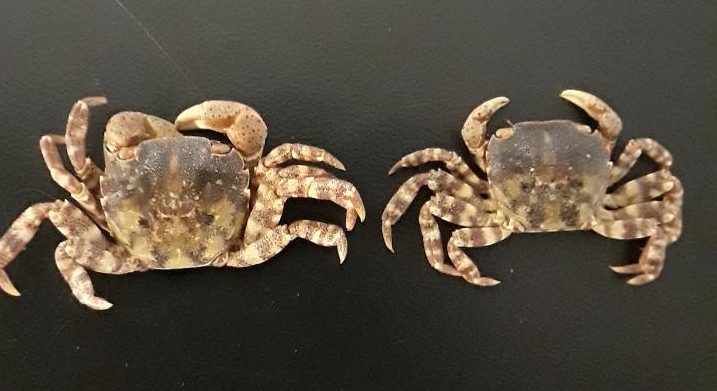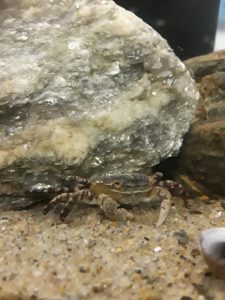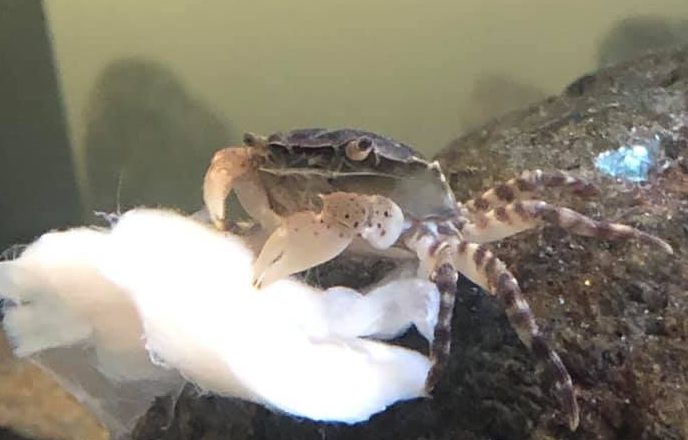This is part of our series about different animals and events at our Blue Ocean Discovery Center. This month we will discuss a favorite Discovery Center inhabitant: the Asian shore crab.
When visitors enter the Discovery Center, the large 4’ by 8’ touch tank is a great attraction. We fill it with salt water, rocks, and seaweed to resemble a tidepool. Visitors are encouraged to turn over the rocks and hunt for periwinkles, barnacles, hermit crabs, and the more than 300 Asian shore crabs that inhabit the tank. We purposely collect only young crabs with very small claws so that our visitors will not be pinched when they find the crabs. For many young visitors, this is their first exposure to tide pool animals and we are happy to assist them in their hunting while instructing them in the necessary gentle handling and care of the animals.
Asian Shore Crab Identification
To identify an Asian shore crab, look for a small crab with a square shell that may be many colors including red, orange, brown, purple or green. There are three spines on each side of the shell. Their walking legs are striped and the males’ claws are different from the females’: there is a fleshy bulb-like structure at the base of the movable part of the claw. They move very quickly and there are often many of them under a rock. The crabs in our touch tank are found in Hampton Harbor and there are often 10-15 of them under one rock! Finding them is very easy.

Invader!
If you were to invent the perfect animal to enter and take over an established environment, it would be hard to outdo the Asian shore crab. The Asian shore crab is an invading species on our coastline, arriving in New Jersey in 1988. It now can be found all along the east coast from North Carolina to Maine. As its name suggests, it is native to Asia, specifically the coasts of Russia, Korea, China and Japan. They probably came to America in the ballast water of cargo ships. Asian shore crabs can live in a wide range of salinities and temperatures and eat many organisms including seaweed, salt marsh grass, young fish and small invertebrates such as amphipods, clams, mussels, barnacles, and worms.
In addition to being able to live almost everywhere and eat almost anything, they reproduce much more than native crabs. Each female crab ca
n produce

50,000 eggs three to four times between May to September, which is twice the reproductive time period for native crabs. Once the eggs hatch, they float as planktonic larvae for up to a month and can travel great distances before they settle to the bottom, allowing for the spread of the invasion. Striped bass and sea gulls may eat the Asian shore crabs, but the very large majority of them escape their predators and continue to reproduce. The perfect invader indeed!
Scientists continue to study the effects of the Asian shore crab’s invasion on the Atlantic coast. Another invasive species, the green crab, has devastated the clam flats in many areas and it is feared that the Asian shore crab may have a similar effect on the ecosystems they inhabit. Next month, we’ll discuss the green crab: a very established invader.
Learn More:
- A Whale of a Summer at the Blue Ocean Discovery Center
- Creature Feature: Horseshoe Crab
- Our Adopted Lobster
- More About the Blue Ocean Discovery Center





